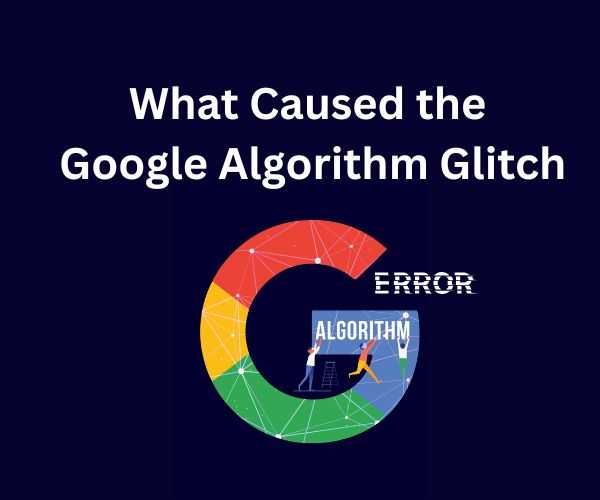Recently, Google confirmed a glitch in its search algorithm that left SEO professionals, webmasters, and digital marketers scrambling for answers.
While the bug was eventually corrected, it revealed a deeper shift in how Google’s algorithms now function – especially with a heightened focus on user experience, content authenticity, and trust.
But what exactly went wrong? And more importantly, what does it mean for your SEO strategy going forward?
In this post, we’ll explore:
- What caused the glitch
- Google’s latest algorithm changes
- The rise of E-E-A-T and semantic SEO
- Why black hat techniques are becoming obsolete
- What you should be doing now to improve your rankings
- FAQs to clear your common doubts
What Was the Google Algorithm Glitch?
The glitch occurred when Google’s core update started behaving erratically. Sites that typically ranked high were suddenly dropping off the first page, and low-quality or spammy sites surged to the top.
🔎 Key Issues:
- High-authority websites lost rankings overnight.
- Inconsistent crawling and indexing.
- Influx of irrelevant results on SERPs (Search Engine Results Pages).
This temporary glitch was tied to Google’s experimental update in how relevance and authority signals were being processed – a part of their broader push toward real user-focused experiences and trust-based rankings.
Shift in Google’s Algorithm: What Changed?
Google made it clear: quality, trust, and authenticity are more important than traditional keyword tricks.
Here are the major changes driving the new era of SEO:
1. ✅ E-E-A-T Is More Crucial Than Ever
Google’s focus on Experience, Expertise, Authoritativeness, and Trustworthiness now plays a major role in rankings – especially for YMYL (Your Money or Your Life) niches like health, finance, and wellness.
Example: A medical blog written by a certified doctor will now rank higher than a random article using the same keywords but written without credentials.
2. 📚 Semantic SEO & Topic Clusters
Instead of just matching keywords, Google now understands search intent and context. That means it’s not just what you say, but how deeply and cohesively you cover a topic.
Example: Writing multiple posts around a topic like “healthy meal plans” (e.g., breakfast, lunch, budget tips, shopping lists) and linking them internally signals depth and relevance.
3. 🚫 Crackdown on Black Hat SEO
The glitch briefly favored websites using outdated black hat methods – like keyword stuffing, spammy backlinks, and cloaking – but Google quickly corrected it.
Post-glitch, such tactics are even more aggressively penalized.
Warning: Using bots to flood low-quality links or hiding content with JavaScript tricks can lead to manual penalties or de-indexing.
4. 📱 Core Web Vitals & UX
Google continues to reward websites with fast load times, mobile responsiveness, and clean navigation.
Tip: Use tools like Google PageSpeed Insights and GTmetrix to monitor your performance.
Common SEO Errors That the Glitch Exposed
- Thin Content – Pages with less than 300–500 words lacking substance.
- Duplicate Pages – Reusing meta tags or copying competitor content.
- Broken Links – Internal or external links leading to 404 pages.
- Improper Redirects – Misuse of 301/302 redirects.
- 301 (Permanent): Correct use when the old page is gone forever.
- 302 (Temporary): Use when you plan to bring the page back soon.
- 301 (Permanent): Correct use when the old page is gone forever.
- Keyword Stuffing – Overusing keywords instead of natural writing.
- Unoptimized Images – No ALT text or overly large file sizes.
How to Get Traffic Post-Glitch: What Works Now?
1. Build Real Topical Authority
Write comprehensive guides, case studies, and FAQs. Make your site the go-to hub for your niche.
Example: A travel site can cover “visa tips,” “packing guides,” “local customs,” and “budget stays” for every country.
2. Outreach with Value
Instead of cold emails, offer collaboration, unique research, or infographic embeds to get backlinks.
Tip: Use tools like Hunter.io, Pitchbox, or LinkedIn for outreach.
3. Leverage Schema Markup
Add structured data for:
- FAQs
- Reviews
- Events
- Local business
This helps Google better understand your content and may boost visibility via rich snippets.
4. Prioritize UX + Content
- Clear headings and navigation
- Mobile-first design
- Actionable CTAs
- Storytelling in blogs and landing pages
FAQ
Q1: Was the glitch a result of a hacker attack?
No. It was due to instability during the rollout of Google’s core update, not a security breach.
Q2: Will this happen again?
Glitches are rare, but algorithm changes are constant. Stay updated via Google Search Central Blog.
Q3: Are backlinks still important?
Yes – but only high-quality, relevant ones. Avoid PBNs, link farms, and paid links from shady sources.
Q4: Is SEO dead with AI search and SGE?
Absolutely not. SEO is evolving, not dying. AI and Google’s SGE (Search Generative Experience) reward well-structured, useful content more than ever.
Q5: How long will it take to recover if hit by a glitch or update?
It depends. If your site follows best practices, it may recover in weeks. If penalties are manual, you’ll need to submit a reconsideration request after fixing issues.
Final Thoughts
The Google algorithm glitch may have been a temporary shake-up, but the underlying message is clear: only high-quality, authentic, helpful websites will win in the long run.
If you’re relying on outdated tricks or ignoring your site’s technical health, you’re playing a dangerous game. Now is the time to:
- Focus on E-E-A-T and user intent.
- Audit your site for content gaps and SEO errors.
- Stay consistent with ethical and strategic SEO practices.
Google’s algorithm may get smarter, but so can your strategy.
Related Articles:
Top 7 JavaScript SEO Issues and How to Fix Them
How To Fix “Blocked due to unauthorized request (401)” in Google Search Console
How to Fix “Crawled – Currently Not Indexed” in Google Search Console


